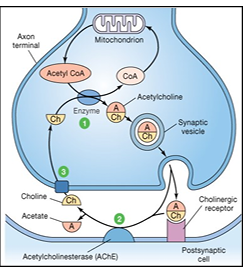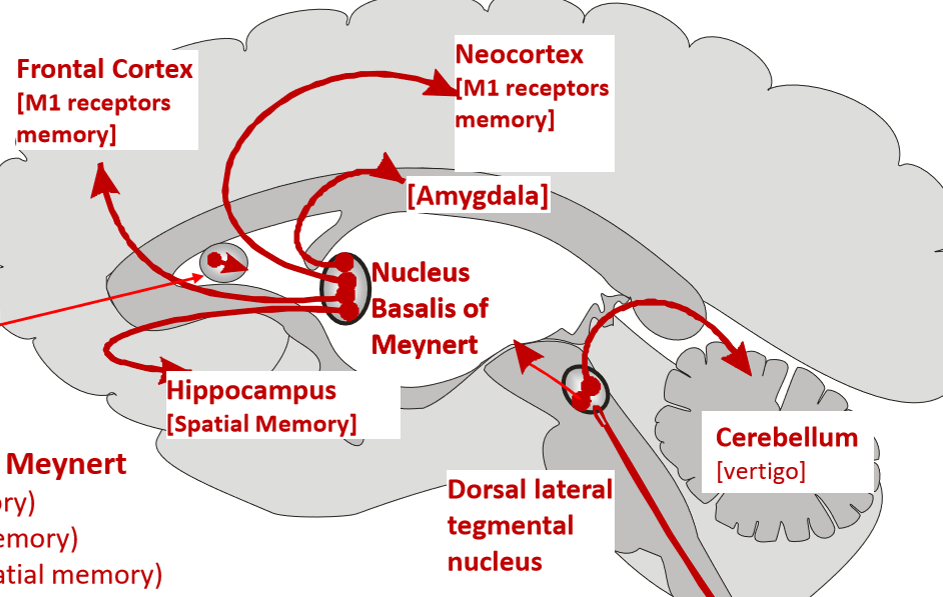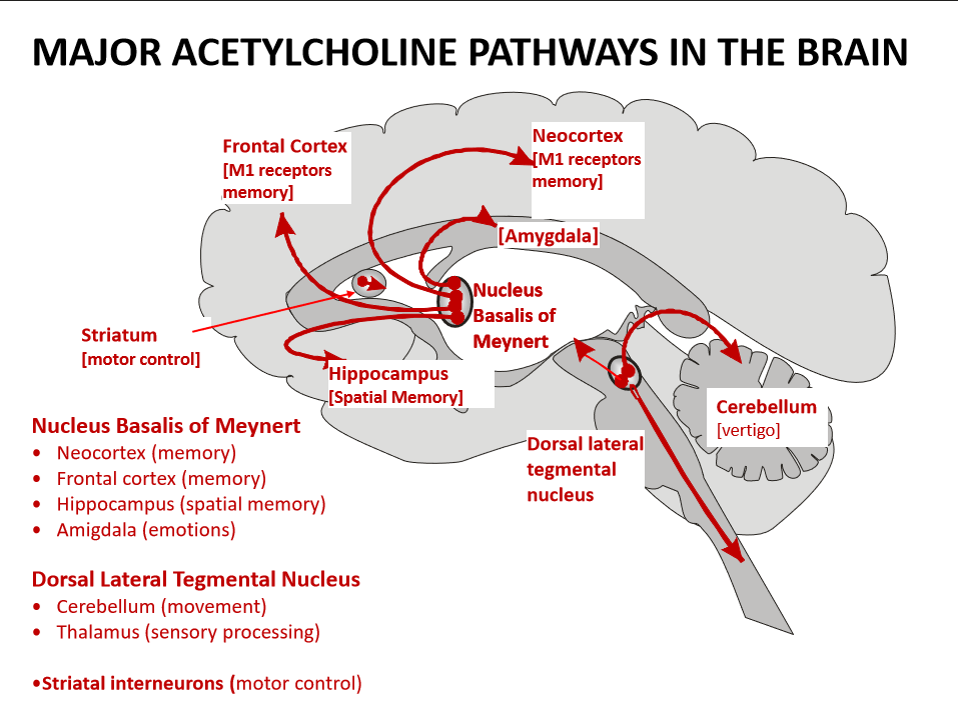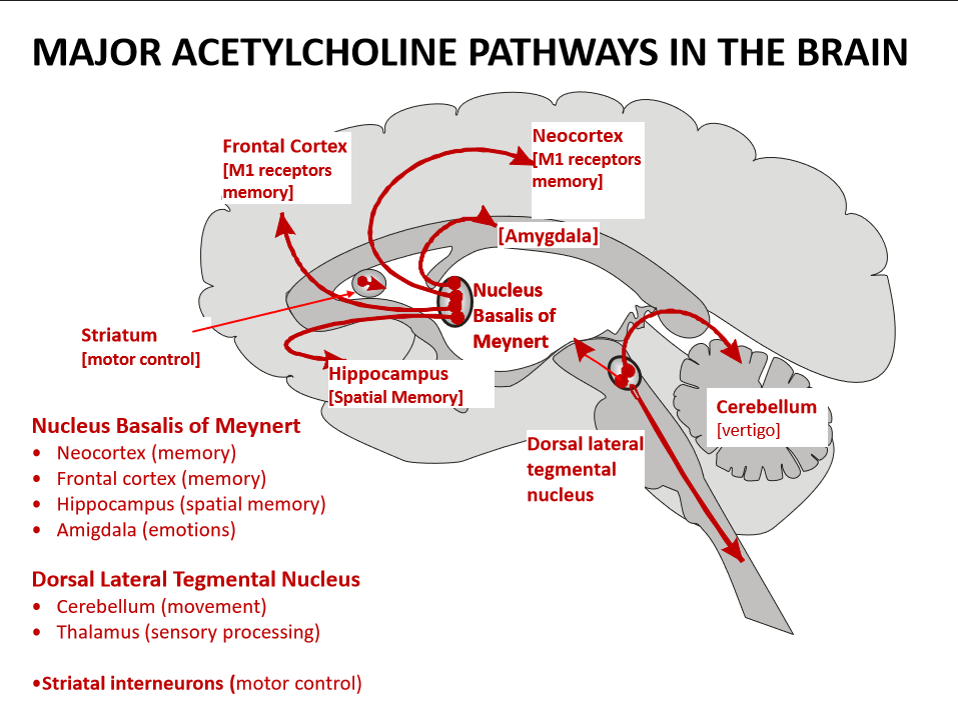acetylcholine
1/60
There's no tags or description
Looks like no tags are added yet.
Name | Mastery | Learn | Test | Matching | Spaced |
|---|
No study sessions yet.
61 Terms
roles of Ach
contraction of skeletal muscles in PNS
ANS
brain - controls plasticity, arousal and reward
what are cholinergic neurones
neurones that synthesise and release Ach
how is Ach synthesised
in presynaptic terminals of cholinergic neurones
choline and actyl-CoA
how is Ach released
action potential arrives → depolarisation of plasma membrane → Ach released via exocytosis
what happens to Ach in synaptic cleft
binds to specific cholinergic receptors to produce either excitatory or inhibitory postsynaptic effects
how is Ach removed from the synaptic cleft
by enzyme acetylcholinesterase and choline is taken up by specific transporter

explain this diagram (key enzymes for synthesis and removal of Ach)
1) choline acetyltransferase makes Ach from choline and acetyl CoA
2) acetylcholinesterase removes Ach from the synaptic cleft
3) choline is taken up by specific transporter
what are the 2 main classes of receptors that Ach acts on
nicotinic (stimulated by nicotine, blocked by curare)
muscarinic (stimulated by muscarine, blocked by atropine)
what are nicotinic Ach receptors
ligand-gated ion channels
how does depolarisation occur in nicotinic Ach receptors
undergo conformational change when Ach binds → change in shape leads to opening of central ion channel pore → influx of Na+ ions into postsynaptic cell → depolarisation → excitation of postsynaptic cell
what are muscarinic Ach receptors
G-protein coupled receptors
how many groups of muscarinic receptors are there
5 groups
M1
M2
M3
M4
M5
which types of muscarinic receptors activate Gq/11 heterotrimeric class G of proteins
M1
M3
M5
muscarinic receptor signalling cascade (M1, M3, M5)
what happens when Ach binds to M1, M3 or M5 receptors
receptor activates a Gq/11 class G-protein
what does the activation of the Gq/11 protein cause
causes alpha-subunit of G-protein to dissociate from βγ subunits.
after dissociation, what does the α-subunit of Gq/11 do
binds to and activates phospholipase C (plc)
what is the function of phospholipase C (PLC) in this signaling pathway
PLC breaks down the membrane phospholipid PIP₂ (phosphatidylinositol 4,5-bisphosphate) into two second messengers: IP₃ and DAG
what does IP₃ do inside the cell
IP₃ binds to IP₃ receptors on the endoplasmic reticulum, causing release of Ca²⁺ from intracellular stores
what is the effect of increased intracellular Ca²⁺ levels
rise in Ca²⁺ contributes to neuronal depolarization and enhances excitability
what is the role of DAG in the Gq/11 pathway
DAG activates protein kinase C (PKC), which phosphorylates various target proteins that modulate ion channels and signaling pathways
how do IP₃ and DAG together influence the postsynaptic neuron
they cause a slow depolarizing excitatory postsynaptic potential (EPSP) through Ca²⁺ release and PKC activation
what is the overall effect of M1, M3, and M5 receptor activation on the neuron
excitation of postsynaptic neurone via slow depolarisation
how does activation of M1, M3 or M5 receptors lead to neuronal excitation: SUMMARY OF CASCADE
upon ACh binding, the receptor activates the Gq/11 protein, causing the α-subunit to dissociate and stimulate phospholipase C (PLC) → PLC produces IP3 and DAG → IP3 triggers Ca²⁺ release from intracellular stores, and DAG activates protein kinase C (PKC) → these events cause a slow depolarizing EPSP, leading to excitation of the postsynaptic neuron
why do M2 and M4 receptors have the opposite effect
because they activate Gi/O heterotrimeric G proteins
how does M2 and M4 receptors cause an overall inhibitory effect when Ach binds
Ach binds → α subunit of these G-proteins disassociate from the βγ subunits → α subunit binds to adenylyl cyclase → leads to inhibition of Ca2+ channels
what is the main source of Ach in the brain
nucleus basalis of meynert (nucleus located in basal forebrain)

what are axons of cholinergic neurones called
cholinergic fibres because they release Ach
where do the axons of these cholinergic neurones project in the brain
project to neocortex, hippocampus, amygdala

which receptors mediate positive effects of Ach on memory consolidation in neocortex
muscarinic M1 receptors
how does Ach influence neocortex
by activating M1 receptors, Ach enhances memory consolidation and supports cognitive processing
where do these cholinergic neurons project to regulate memory formation
to hippocampus
why is Ach release in hippocampus important
because it regulates memory formation and learning process
which brain region receives cholinergic projections that influence emotional processing
amydala
how does Ach affect amgydala
it modulates emotional responses and contributes to emotional aspects of memory
apart from major projection systems, where else is Ach released in the brain
from interneurons in the striatum (local circuit cells) and neurons in the dorsolateral tegmental nucleus of the midbrain
what is the function of striatal cholinergic interneurones
they modulate motor control and coordinate activity between dopaminergic and GABAergic systems in the basal ganglia
what are the main projection targets of dorsolateral tegmental nucleus
the thalamus and cerebellum
how do cholinergic projections to the thalamus affect brain function
they regulate sensory processing and attention by modulating thalamic relay activity
what is the role of cholinergic projections to cerebellum
they regulate movement coordination and fine motor control
in summary, what are the main functional roles of Ach in the brain
Memory consolidation (neocortex, hippocampus)
Emotional regulation (amygdala)
Sensory processing (thalamus)
Motor coordination (striatum, cerebellum)

true or false: both muscarinic and nicotinic Ach receptors mediate activity in the autonomic nervous system
true
example of nicotinic receptor agonists
nicotine
what can excessive activation of nicotinic receptors by nicotine cause
convulsions due to overstimulation of CNS nicotinic receptors
convulsions are involuntary, rapid contracting and relaxing of muscles causing uncontrolled shaking or jerking of body
example of muscarinic receptor agonist
compounds found in amanita mushrooms (e.g. muscarine)
what are CNS effects of muscarinic receptor agonists
vertigo
confusion
weakness
coma (at higher doses)
what are PNS effects of muscarinic receptor agonists
salivation
sweating
pupil contraction
dyspnea
abdominal pain
diarrhoea
why do muscarinic agonists cause these PNS effects
they mimic parasympathetic stimulation by activating muscarinic receptors in target organs
what are 2 examples of muscarinic receptor antagonists
atropine
scopolamine
what are the central effects of muscarinic receptor antagonists at therapeutic dose
drowsiness
euphoria
amnesia
fatigue
what are the central effects of muscarinic antagonists at higher doses
excitement
restlessness
hallucinations
why do muscarinic antagonists have mild anti-Parkinson effects
they block cholinergic activity in striatum, helping to rebalance dopamine and Ach levels
what are the peripheral effects of muscarinic antagonists
Pupil dilation (mydriasis)
Decreased salivation
Reduced pharyngeal and respiratory secretions
Increased heart rate (tachycardia)
Decreased gut motility and secretion
Decreased bladder tone
why do muscarinic antagonists cause pupil dilation and dry mouth
by blocking parasympathetic input to iris sphincter and salivary glands
what do anticholinesterase inhibitors do
they block acetylcholinesterase, preventing Ach breakdown and causing Ach accumulation at synapses
why can anticholinesterase inhibitors be toxic or lethal
because excess Ach overstimulates cholinergic receptors leading to convulsions, paralysis and respiratory failure
why is anticholinesterase used to treat myasthenia gravis
to enhance neuromuscular transmission
what are CNS effects of anticholinesterase poisoning
slurred speed
confusion
loss of reflexes
conculsions
what are the PNS effects of anticholinesterase poisoning
pupil constriction
watery nasal discharge
nausea and vomiting
sweating
abdominal cramps and diarrhoea
why do anticholinesterases cause both CNS and PNS symptoms
because Ach accumulates throughout nervous system, overactivating both muscarinic and nicotinic receptors
summary of differences between cholinergic agonists, antagonists and anticholinesterase
Agonists → mimic ACh and stimulate receptors.
Antagonists → block ACh and inhibit receptor activity.
Anticholinesterases → increase ACh levels by preventing its breakdown.